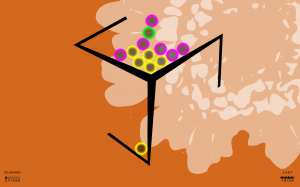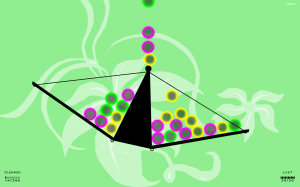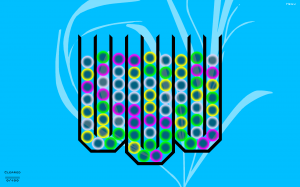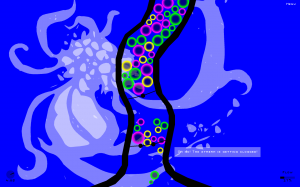Chains: The End
Finishing the remainder of the levels in a burst has left my hand worn-out. I suppose this is one of the areas where the touchscreen version is superior. You might think that the laptop trackpad I’ve been using isn’t too far removed from a touchscreen, as far as the hands go, but you use two things at different angles. Also, with a touchscreen, it would be impossible to lose track of where the cursor is, as happened to me occasionally. So I’d suggest playing this on a phone if you have any desire to play it at all. Too bad Steam doesn’t support such devices yet.
Overall, I have mixed feelings about this game. It does some good experimentation with types of challenge, but only on some of the levels. Plus, the experimental parts, like any true experiments, fail sometimes. For example, there was one level toward the end (the only no-time-pressure level that posed any real challenge) where you have to balance the bubbles in two pans of a scale — each bubble has a number inscribed on it indicating its weight. Your only way to alter the contents of the pans is of course by deleting chains, and bubbles you delete are replaced with new ones, weighing a different amount, after a substantial delay. Anyway, I never really solved this one: I was just getting the hang of thinking in terms of value differences between chains, when all of the sudden it solved itself. Some random replacement bubbles came in that just happened to match the weight of the other pan. I’d feel cheated, and want to try again and do it right, except for the fact that the puzzle wasn’t all that engaging, and doesn’t really have much of anything to do with the game’s core mechanic.
 Probably my most positive experience was on the penultimate level, titled “The Mill”. Here, bubbles fall in batches into the buckets of a three-lobed whirligig, which spins slowly to spill what it holds. The goal is to delete 300 without losing 20. Frequently it’s impossible to nab the last crumbs in a batch. This is a time-pressure level, but it strikes me as having just the right degree of pressure: the mill rotates slowly enough that I wasn’t just frantically trying to pick things off as quickly as possible, I was thinking about optimization. Also, my own victory here was particularly dramatic. There came a point when I was very close to making quota, but the unchainable residue in a batch was going to put me over the limit when it fell. I hadn’t been paying much attention to the nearly-emptied buckets after I nearly-emptied them, so I wasn’t sure exactly when in the cycle they dumped their load, relative to when the new batch came. When the new batch did in fact come just in time for me to win before I lost, it felt like the cavalry had arrived in the nick of time.
Probably my most positive experience was on the penultimate level, titled “The Mill”. Here, bubbles fall in batches into the buckets of a three-lobed whirligig, which spins slowly to spill what it holds. The goal is to delete 300 without losing 20. Frequently it’s impossible to nab the last crumbs in a batch. This is a time-pressure level, but it strikes me as having just the right degree of pressure: the mill rotates slowly enough that I wasn’t just frantically trying to pick things off as quickly as possible, I was thinking about optimization. Also, my own victory here was particularly dramatic. There came a point when I was very close to making quota, but the unchainable residue in a batch was going to put me over the limit when it fell. I hadn’t been paying much attention to the nearly-emptied buckets after I nearly-emptied them, so I wasn’t sure exactly when in the cycle they dumped their load, relative to when the new batch came. When the new batch did in fact come just in time for me to win before I lost, it felt like the cavalry had arrived in the nick of time.
Levels in this game end with a peculiar lack of fanfare. There’s always an on-screen display of your progress, but it’s small and doesn’t draw attention to itself, and finishing a time-pressure level usually requires enough concentration that I don’t go looking for it. (The Mill is one of the few that permitted that luxury.) So winning doesn’t involve a great sense of anticipation, and can feel abrupt: you’re in the groove, making chains fast enough to keep pace, and then things just stop. A little text message appears in the center informing you that you’ve unlocked the next level, and would you like to go there now? And that’s all the recognition you get of your accomplishment at that moment. Beating the last level at least takes you to the credits screen, which thanks you for playing.
The credits screen is interactive, by the way: the words “THE END”, made of movable letters, are in a bin of bubbles, which you can chain to your heart’s content. There’s no goal here, and anything you delete is replaced from the top, but you can at least do things like undermine the bubbles supporting the letters and make them fall over or out of place.
Overall, this is a very elegant game. I mean this both in the visual sense — it has a clean, simple aesthetic that I find quite attractive — and in the mathematical sense — this is a game that gets a lot of mileage out of very simple rules. I think I liked it more than I disliked it, if only because it did manage to develop its core mechanic in unanticipated directions.
 Comments(0)
Comments(0)

